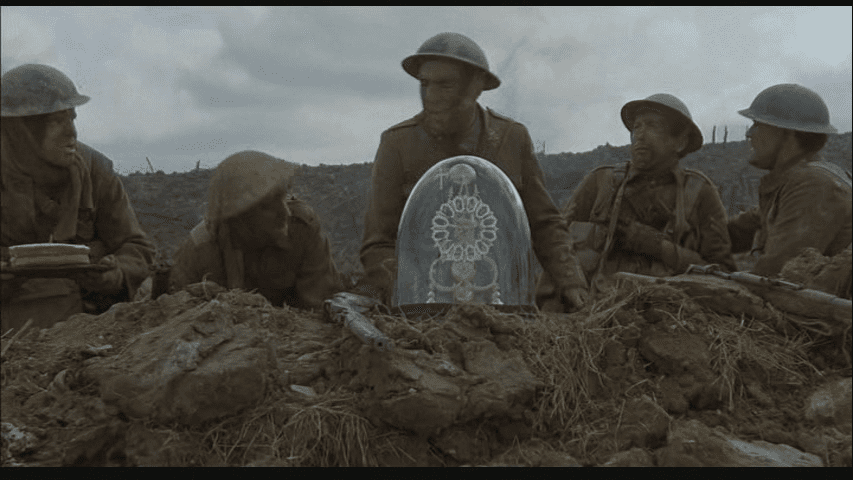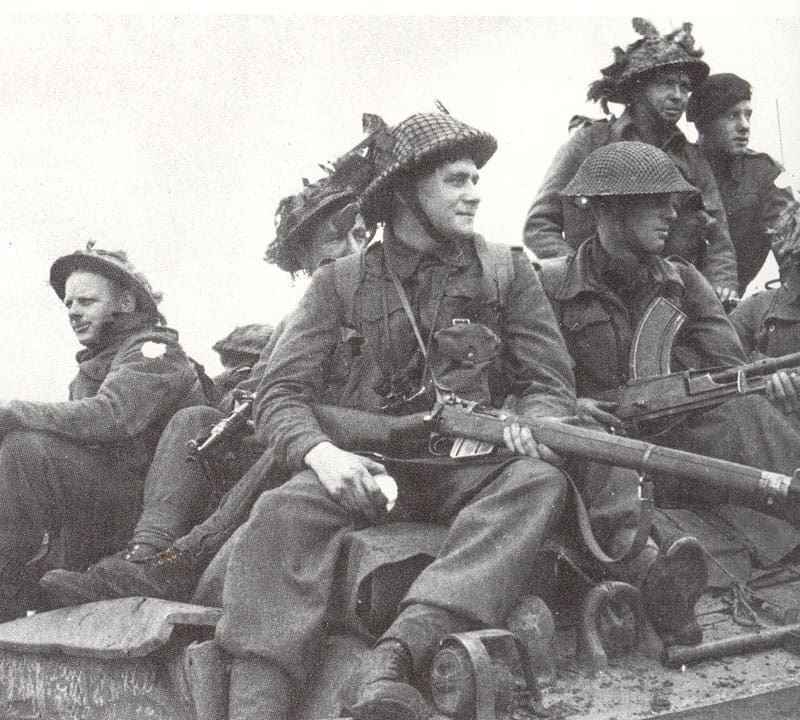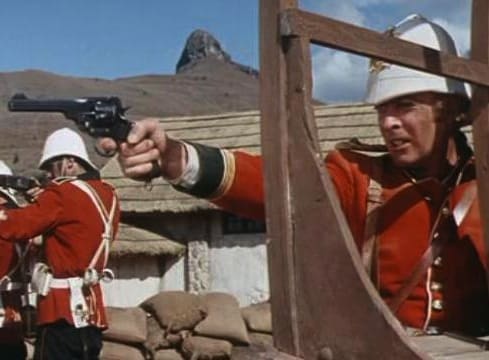Tonight’s episode was all about guns from our favorite gun control paradise: Great Britain. I tried taking an English co-worker into a range trip a few weeks back, but unfortunately the freedom was just too much for his fragile brain and he hasn’t been quite the same ever since. Then again, he wasn’t quite all there to begin with. Anyway, I digress. To the guns!
Short Magazine Lee-Enfield (SMLE) Mk. III
This is one of the only British firearms that I’ve ever wanted to own, mainly because it is such an interesting piece of technology.
The Lee-Enfield rifle started life in 1888 as the Lee-Metford rifle, combining Mr. Lee’s cocking technology with Mr. Metford’s rifling. However, as smokeless powder overtook black powder as the propellant of choice, it was discovered that Mr. Metford’s rifling system was inadequate and quickly wore away with repeated use. Mr. Enfield designed a more robust rifling technique, and the Lee-Enfield began introduction about 1895.
What makes this weapon particularly interesting to me is that the firearm is cocked when the bolt moves forwards.
On most rifles, the action of opening the bolt is what causes the firing pin to cock backwards. The Mauser action was one of the first to use this system, and the U.S. m1903 rifle followed suit with a similar system. The effect was that it was much more difficult to open the bolt than to close it, and required more force and more leverage. With the SMLE the bolt cocked back as the bolt went forward, meaning that when opening the bolt the action nearly springs open with very little assistance. This development made the gun very quick to cycle and meant that (with the exception of a straight pull bolt like the Schmidt Rubin) it was and probably still is the fastest bolt action design on the battlefield.
The name of the design, specifically the “short” part, refers to the barrel and not the magazine. The magazine size has remained constant since the initial development of the rifle, holding 10 rounds of ammunition typically loaded via stripper clips. It’s a common misconception that the “short magazine” is all one phrase, indicating the magazine had been shortened.
I’m fairly certain that this is the Mk. III (I have to admit I don’t watch these shows live), but based on the length of the barrel and the shape of the cocking piece it looks like a smelly mark three to me.
Webley Revolver
While the Enfield revolver was technically the official sidearm of the King’s armed forces, the Webley was by far my favorite during WWII. First introduced during The War to End All Wars, the Webley Mk. VI in .455 caliber was an improvement over the 1887 design in a few minor ways, but in reality it was the exact same weapon used to keep savage Zulus at bay all those years ago.
The most remarkable feature of this gun was its “break action” design. Instead of having the cylinder swing to one side for loading or having a loading gate at the rear of the frame, the entire gun simply hinges upwards exposing the breech end of the cylinder. This made loading and unloading easier, especially since the extractor automatically ejected the spent casings.
Unfortunately, by the beginning of WWII, the Webley was already massively out of date. The American M1911A1 was in service by then and even the Germans had moved on to semi-automatic magazine fed handguns. The Webley would continue to see use as the preferred sidearm of police agencies within the realm, but even in that role it has been largely phased out. Webleys can still be found in combat in the Middle East and Africa, and generally anywhere the British had an influence at one time, but the only production models still available are reproductions.
What did I think of the weapon choice for this week? For one thing, if they were going to do a show focusing on English firearms they’ve hit the nail squarely on the head. Unless they wanted to scrounge up some Baker rifles or a Brown Bess somewhere, these are the two firearms that immediately spring to mind when I think of “English firearms.” Great Britain isn’t exactly known for its affinity for firearms – certainly not any more – so naturally their production of iconic firearms has been somewhat lacking compared to their redneck cousins across the pond. Heck, even the French have had more luck in that field.
Even with the island nation’s lackluster overall record, though, these two firearms are definitely worthy of attention on the same level as the other firearms of the period and perhaps moreso for the impact they have had on the world in the hands of the Empire’s forces overseas.







That episode was a hoot, I really enjoyed it. This season is a big improvement over past ones.
The father of a high school friend owned a Lee-Enfield sniper rifle that included the scope with its case. It was really nice.
The Enfield rifle in the picture is actually a No. 4 Mk 1. British and Commonwealth armies started WW2 with the SMLE but transitioned to the No. 4 in 1941-2.
The rifle shown in the top picture are indeed SMLE No. 1 Mark III’s – the characteristic “ears” protecting the barrel mounted rear sight on te rifle at the far right is the giveaway.
The B&W picture shows a No. 4 Mark II or Mk II* with the target type rear sight (the Mark I rear sight was a simple L shaped type with a fixed 300 and 600 yard aperture sight). The Mark II rear sight is the better one – folded it has an aperture peep sight (or a “ghost ring” sight for battle use) and when raised a finely made adjustable aperture sight similar to but better then the Enfield M1917.
The No. 4 rifle was designed between the World Wars to be cheaper and quicker to produce than the No. 1 Mk III with a beechwood stock and a lighter barrel and a spike bayonet (greatly hated by the troops).
Britain produced the No. 4 rifle and placed contracts with Savage and Longbranch in Canada. The commonwealth countries didn’t have the drawings or the tooling to produce the No. 4 so continued to produce the No. 1 Mk III (most notably Lithgow in Australia in in various factories in India). A good No. 1 Mk III is a pleasure to shoot, although if you want one for target work, search out a No.4 Mk II with the adjustable aperture sights
“Great Britain isn’t exactly known for its affinity of firearms”
Wrong, wrong, wrong. Maybe their government but the Brits have always and continue to this day to make world class firearms of impeccable quality most of us can’t dream to afford.
Look into Holland and Holland, John Rigby, Boss & Co, Purdey & Sons, W.J. Jeffery and Westley Richards.
The Brits are world renown for firearms. Many of the finest quality and most collectible firearms are made by the British firms I mentioned.
You forgot to mention the offers of Accuracy International. Some of those rifles make me want to……shoot. I do believe I saw their 338 Lap. Mag. in the preview for next week’s episode (1500 m shot).
You are absolutely correct Jeff. I was remiss to forget Accuracy International. One of their .338’s would be an absolute hoot to shoot.
Looks more like the FN Ballista they have had in the opening credits. Not to dash your hopes — I want it to be an AI as well.
I think we’re getting mixed up in semantics here.
Britons are GREAT for making one-of-a-kind quality firearms and small runs thereof, but name one commercial brand off the top of your head that is regularly seen in American gun shops.
Much like British cars these days, the ones you want you can’t afford and the ones you can afford you don’t want.
APBTFan: Absolutely. Your list is quite good. I have a quail gun from 1937 built on a Greener Cross Bolt action, custom finished, sold by Abercrobie & Fitch…in 1937 to my grandfather. Lovely gun. Proportions are perfect. To this day I wish that Peter Sellers had lived long enough to take delivery of his London Best Gun. Then die, with a hint of heaven beforehand.
At the very least he blessed us all with his performance in Dr. Strangelove!
Whatever happened to the London Best Mr. Sellers ordered?
Thank you, I was wondering how long it would take for someone to bring this up!
v/r
C_S
Who said Zulus were savages? Thats not very nice.
The Zulus acquitted themselves very well for not having firearms.
They sure did.
They did have firearms, and they outnumbered the British 100 to 1.
This development made the gun very quick to cycle and meant that (with the exception of a straight pull bolt like the Schmidt Rubin) it was and probably still is the fastest bolt action design on the battlefield.
I have read a couple of independent reports that some soldiers could get insane rates of fire by using their middle finger on the trigger, flipping the bolt up and back with their index finger, catching and closing it with their thumb. My right thumb is buggered enough that I’ve never been able to try this out. Any of the AI want to do a theory-to-practice?
That’s one of the techniques that Iain Harrison was trying to pass on to the shooters last night on Top Shot.
That said, I can’t wait for Sons of Guns tonite, because it’s pretty much guaranteed I’ll see something that’s neva been dun befo.
Sorry it’s another clock, sir,…
[boom]
…only there was a bit of a mix-up. Well, Walters thought he was buying the present, and Spadger and I had already got the other one.
Ive heard that the ballistic performance of the .303 was fairly poor. Any truth to that?
Not for the time period.
Not to be a correctness nazi, but during the British conflicts with the Zulus, officers were actually issued with Adams Mk. III revolvers, as the Webley had not yet been adopted.
I was under the impression that officers were generally responsible for sourcing their own sidearms prior to WW1. Must have caused a headache for the quartermaster.
Friend of mine had a Canadian Mark 4 Lee Enfield. It had been laying around the house for a long time and it was his deceased Uncle’s rifle. I bought some ammo for it and we played with it. It really was not a bad rifle and really did not kick too bad. One thing that was odd, in that it seemed the bullet was hard to push out of the magazine and up the feed ramp into the chamber. Gun was butter smooth with just cycling an empty action. My guess is the magazine may have gotten screwed up slightly. Still a bit of a mystery.
Small point, here, but cocking the piece when closing the bolt seems easier and faster to do from a mechanical and physical effort standpoint, as opposed to cocking on the bolt-pull. (Feels more satisfying, too.)
I have a hunch your triceps (the main muscle involved in pushing the bolt closed) acts faster than the biceps (main muscle for pulling the bolt).
I agree. I have a No.4 Mk. 1 and it is super quick to cycle. The Brits had the “mad minute” which consisted of at least 15 hits on a 12″ target at 300 yards and many rifleman could score 30+ hits in that time. Seriously impressive.
To see some of these “mad minutes,” Google mad minute lee enfield youtube
Not to nit pick TOO much, but there was no ‘Mr. Enfield’ – Enfield comes from the Royal Small Arms Factory in Enfield. The rifling was designed by the Factory’s own engineers rather than outside designers, like the Metford rifling.
Enfields are fine, fine rifles. My No.4 Mk.2 (with the micrometer adjustable target sights) is a tack driver. It’s tied with my Swiss K31 as my favorite bolt action rifle ever.
From the comments in your article it is quite clear you know nothing either about British firearms or UK firearms legislation rather the Un-informed stereotypical nonsense we can expect from the cousins across the sea.
The reality is that the UK has produced some of the most accurate and iconic weapons ever devised.
Up to and including the Accuracy International series of peerless rifles as well as the SA80A2 considered the most accurate assault rifle ever produced.
From the comments in your article it is quite clear you know nothing either about British firearms or UK firearms legislation rather the Un-informed stereotypical nonsense we can expect from the cousins across the sea.
The reality is that the UK has produced some of the most accurate and iconic weapons ever devised.
An example would be the Accuracy International series of peerless rifles as well as the SA80A2 considered the most accurate assault rifle ever produced, finally English shotguns are considered pre-eminent in the shooting world.
Regarding gun control, I am allowed to possess up to and including .50 calibre, I personally own a Lantac Raven in 5.56, a AI AWSM 338 and a Marlin 1894C .357 magnum lever action.
Comments are closed.